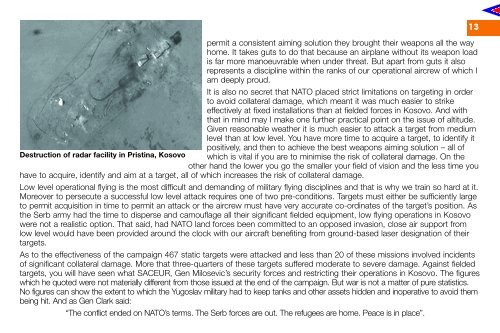THE RAF AIR POWER REVIEW - Royal Air Force Centre for Air ...
THE RAF AIR POWER REVIEW - Royal Air Force Centre for Air ...
THE RAF AIR POWER REVIEW - Royal Air Force Centre for Air ...
You also want an ePaper? Increase the reach of your titles
YUMPU automatically turns print PDFs into web optimized ePapers that Google loves.
permit a consistent aiming solution they brought their weapons all the way<br />
home. It takes guts to do that because an airplane without its weapon load<br />
is far more manoeuvrable when under threat. But apart from guts it also<br />
represents a discipline within the ranks of our operational aircrew of which I<br />
am deeply proud.<br />
It is also no secret that NATO placed strict limitations on targeting in order<br />
to avoid collateral damage, which meant it was much easier to strike<br />
effectively at fixed installations than at fielded <strong>for</strong>ces in Kosovo. And with<br />
that in mind may I make one further practical point on the issue of altitude.<br />
Given reasonable weather it is much easier to attack a target from medium<br />
level than at low level. You have more time to acquire a target, to identify it<br />
positively, and then to achieve the best weapons aiming solution – all of<br />
Destruction of radar facility in Pristina, Kosovo which is vital if you are to minimise the risk of collateral damage. On the<br />
other hand the lower you go the smaller your field of vision and the less time you<br />
have to acquire, identify and aim at a target, all of which increases the risk of collateral damage.<br />
Low level operational flying is the most difficult and demanding of military flying disciplines and that is why we train so hard at it.<br />
Moreover to persecute a successful low level attack requires one of two pre-conditions. Targets must either be sufficiently large<br />
to permit acquisition in time to permit an attack or the aircrew must have very accurate co-ordinates of the target’s position. As<br />
the Serb army had the time to disperse and camouflage all their significant fielded equipment, low flying operations in Kosovo<br />
were not a realistic option. That said, had NATO land <strong>for</strong>ces been committed to an opposed invasion, close air support from<br />
low level would have been provided around the clock with our aircraft benefiting from ground-based laser designation of their<br />
targets.<br />
As to the effectiveness of the campaign 467 static targets were attacked and less than 20 of these missions involved incidents<br />
of significant collateral damage. More that three-quarters of these targets suffered moderate to severe damage. Against fielded<br />
targets, you will have seen what SACEUR, Gen Milosevic’s security <strong>for</strong>ces and restricting their operations in Kosovo. The figures<br />
which he quoted were not materially different from those issued at the end of the campaign. But war is not a matter of pure statistics.<br />
No figures can show the extent to which the Yugoslav military had to keep tanks and other assets hidden and inoperative to avoid them<br />
being hit. And as Gen Clark said:<br />
“The conflict ended on NATO’s terms. The Serb <strong>for</strong>ces are out. The refugees are home. Peace is in place”.<br />
13

















